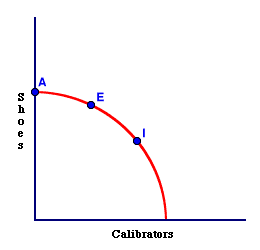
|
|
NONDURABLE: A good bought by consumers that tends to last for less than a year. Common examples are food and clothing. The notable thing about nondurable goods is that consumers tend to continue buying them regardless of the ups and downs of the business cycle.
Visit the GLOSS*arama
|
|


|

|
|
Lesson 4: Production Possibilities | Unit 5: Investment
|
Page: 19 of 24
|

|
Investment is the tradeoff between consumption goods used for current satisfaction and capital goods that expand future productive capabilities.- Investment is not just putting money into the stock market. Investment is giving up current satisfaction to obtain greater future production, usually seen as giving up consumption goods to produce capital goods.
- Education and human capital that increase the productive skills and ability of labor.
- Exploration for mineral or fossil fuel deposits that add to land resources.
- Scientific research that expands technology and resource quality.
- The downside of investment is risk. There is no guarantee that you'll get something tomorrow.
Let's consider this basic tradeoff between capital and consumption.- Capital and consumption are the two basic types of goods needed for investment. If we produce more calibrators (capital), then we give up some jogging shoes (consumption).
- This tradeoff IS the fundamental act of investment. In the graph to the right, if we move from bundle A to E to I, we are giving up jogging shoes and getting calibrators.
We are investing!
|
|
|
|
|

|
|
CENTRAL BANK The banking authority of a nation that is charged of ensuring a sound money supply and conducting the country's monetary policy. It is usually officially authorized by, and works closely with, the other government policy makers to achieve full employment, low inflation rates, and economic growth. The Federal Reserve System is the central bank of the United States.
Complete Entry | Visit the WEB*pedia |



|

|
BEIGE MUNDORTLE
[What's This?]
Today, you are likely to spend a great deal of time touring the new suburban shopping complex looking to buy either a genuine down-filled pillow or one of those "hang in there" kitty cat posters. Be on the lookout for defective microphones.
Your Complete Scope
This isn't me! What am I?
|

|
|
The first "Black Friday" on record, a friday marked by a major financial catastrophe, occurred on September 24, 1869 -- A FRIDAY -- when an attempted cornering of the gold market induced a financial crises and economy-wide depression.
|

|
|
"Experience keeps a dear school, but fools will learn in no other. " -- Benjamin Franklin
|

|
LIFO
Last In First Out
|

|
|
Tell us what you think about AmosWEB. Like what you see? Have suggestions for improvements? Let us know. Click the User Feedback link.
User Feedback
|


|


